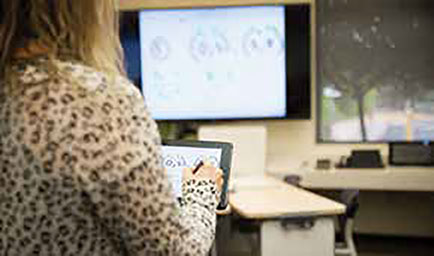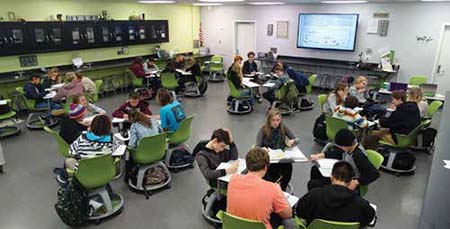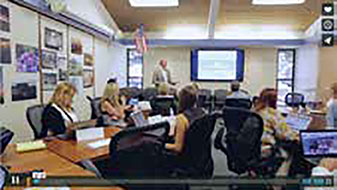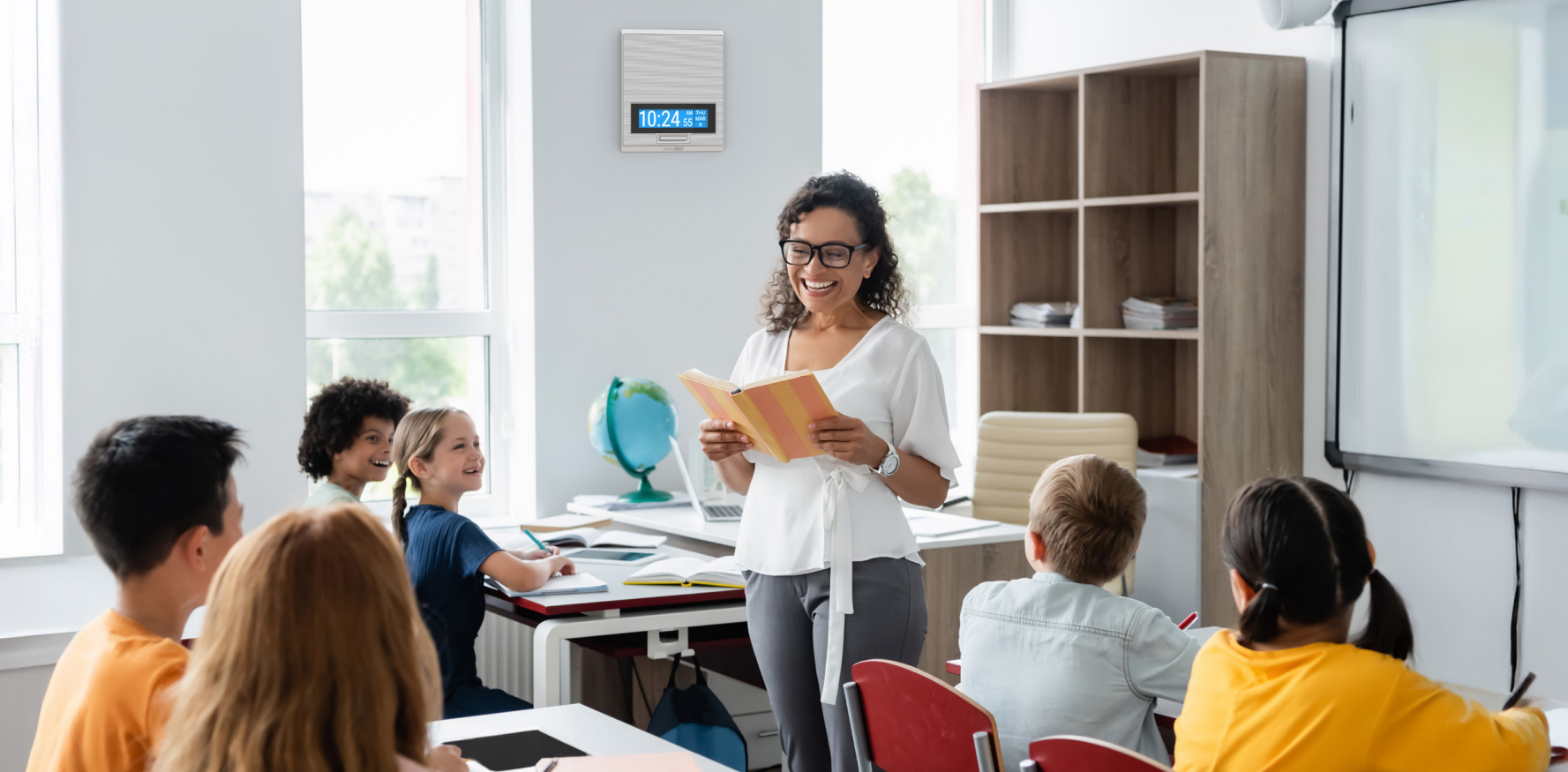An Invitation to Inspiring Learning Spaces

Teachers and students can project with their iPads, MacBooks, Chromebooks, or Windows machines
using Air Parrot. Outside of our schools, we have seen an increasing intersection between the virtual and the physical world, yet our classrooms have largely remained unchanged for over 100 years. This problem spurred Laguna Beach Unified School District in California to embark on an ambitious journey called the “4Cs Learning Environments” (4CLE) to re-envision how to improve learning by creating inspiring learning spaces.

DECISION BY COMMITTEE
To begin the 4CLE project, the district formed a committee comprising principals, administrators, classified staff, and teachers. This committee used the book, The Third Teacher, written by an international team of architects and designers, who explore the link between the school environment and how children learn as a foundation for their discussion. The input from all of the groups is vital, but teachers in particular feel the power of group encouragement.
Part of the exploration of inspiring spaces was visiting some of the high-tech companies in Irvine, CA, as well as innovative schools. By looking at businesses, the district saw the importance of smaller collaborative settings and visual displays. The workers’ desks were not in cubicles, but arranged to allow for additional seating and multiple displays to help communicate in smaller, informal learning groups.
“We designed our company work area to be highly collaborative, with ‘hotel seating' so that anyone can informally create a group discussion,” says local business owner Lane Rankin of Illuminate Education. “Allowing for all levels of our team to communicate efficiently helps us maintain a vibrant and living work space. We have multiple displays that give us the status of the company but can be instantly switched wirelessly to a presentation from anyone’s iPad/iPhone or computer.”
The committee decided not to wait to make a comprehensive plan. They knew that this would be an iterative process, so they began by testing ideas in nine incubator classrooms.
Much of the furniture is on wheels and students can move from circles to rows to groups in less than a minute per switch. (Pictured: the Steelcase Node desks.)FUNDING REDESIGNED LEARNING ENVIRONMENTS
Tools and ideas to transform education. Sign up below.

The 4CLE project was funded through a general fund, parent donations, and donations from vendors willing to use the district as a test site. Often vendors like to get in on the ground floor of pilot programs that they can use to showcase their products in a school setting.
To keep the program going and growing, districts will need to look toward grants and garner support for local bonds that can be used to support ongoing efforts toward rethinking learning spaces. Many districts have passed bonds that help with updating infrastructure. Modernization funds can also be used to retrofit classrooms. It is also important to try to leverage your ideas with existing funding. If you want to move your classroom to LED lighting, for example, check your local energy company for rebates and incentives.
CREATING INSPIRING LEARNING SPACES
Creating inspiring learning spaces within the context of a single classroom can be very challenging. The space of a typical room is usually less than 900 square feet. Here are the main changes Laguna Beach made to re-invent their learning spaces:
■ Removing Clutter: Studies show that removing clutter increased time on task and improved test scores.
■ Purchasing mobilize furniture. Laguna Beach classroom designs became “transformer” classrooms that could morph from didactic teaching to collaborative groups then back to a Socratic circle in less than a minute. Everything has wheels, including some of the teacher desks. In many rooms, they removed bulky cabinets and replaced them with floating file cabinets that students can sit on.
■ Adding multiple display systems in each room to maximize the classroom stage. There is no longer a front of the classroom. To encourage immersive presentations, Laguna Beach has added as many as three 70”-80” LED monitors to a classroom, all with ability to show the same screen wirelessly through Apple TV. These displays are brighter than LCD projectors so more natural light can be allowed in while the displays are on.
■ Adding color: Studies have shown that different colors have an impact on classroom activities. Reading may be better with a calming yellow, while collaboration is encouraged by blue. Perhaps the question is not what color to paint the walls but what color to light the walls. Laguna Beach has been experimenting with HUE lighting by Philips to change the color of their walls. Teachers point LED lights toward white walls and then use an iPad app to change the color of the walls and the mood of their classrooms with just a click of a button.
■ Adding amplification: Studies show that using audio amplification can decrease teacher stress levels at the end of the day. Audio amplification and microphones can also be a way to increase collaboration. Each student group has a microphone and a speaker at their desk. Using a FlexCat system by LightSpeed, a teacher with an earbud can listen in remotely to groups working together. The teacher can also speak directly to any individual student or groups of students from the microphone without interrupting the group’s collaboration.
■ Plants: Studies show that the introduction of plants in classrooms with few windows did not improve test scores, but they did increase the students’ positive perception about the classroom.
■ Air conditioning: The AC was set as a standard in all classrooms because studies showed 72 degrees was the optimal learning temperature for most students.
■ Sit and Stand desks: These desks were deployed in some classrooms and are not only popular with students, but the added engagement of leg muscles in active learners allows them to focus.
■ Stools: Buoy (Steelcase) and Hokey (VS furniture) stools were deployed to increase movement while sitting. This has been shown to decrease bad posture and stagnant positions, making the focus on learning easier.
■ Whiteboards: The district deployed Verb desks with attached hanging whiteboards that can be assembled on an easel or a board to facilitate process planning and checking for understanding.
LESSONS LEARNED
The Laguna Beach committee has tried things that haven’t worked, but they are encouraged by the thought that they are “failing up” and that this collective learning makes them better at identifying what is critical in the classroom. An added benefit of this redesign is that teachers are enjoying their work spaces more. Empowering teachers to change their classrooms can be the spark to encourage and enable our students to change the world. How will you embark on your journey to create inspiring learning spaces?
Michael Morrison is the chief technology officer of Laguna Beach Unified School District in California. He has been awarded the Gold Disk by CUE. Follow Michael on Twitter @MyTakeOnTech or email him at mmorrison@lbusd.org.
Visit the online edition of this issue to see the 4CLE spaces in action.

